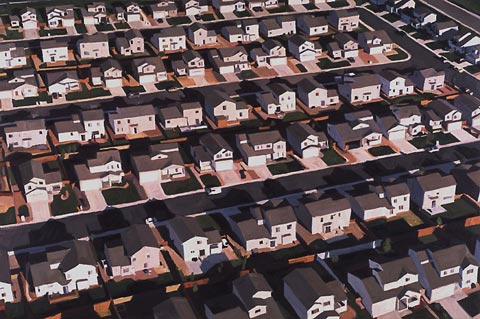
Sarah McKenzie, Aerial 53, 2002, oil on canvas, 48" x 72"
"O Beautiful, for spacious skies, for amber waves of grain, has there ever been another place on earth where so many people of wealth and power have paid for and put up with so much architecture they detested as within thy blessed borders today?"
- Thomas Wolfe, from the introduction to "From Bauhaus to Our House"
Until about five years ago, Sarah McKenzie, an artist who lives in Boulder, Colorado, painted aerial views. Her work up to that point had been about suburban sprawl, a subject perfectly in tune with the blowing up of the Housing Bubble. Choosing mass architecture as subject matter allowed McKenzie to be a bit of a social anthropologist -- she could quietly hint at her disdain -- and it provided some striking visual material.
McKenzie's aerial paintings, numbered sequentially, have a documentary feeling about them. They established McKenzie as a straightforward painter who avoided irony and brought an "it is what it is" approach to her artistic process. Her use of overviews also did a good job of reinforcing the idea that she was a detached observer.

Sarah McKenzie, Aerial 62, 2002, oil on canvas, 48" x 48"
Currently on View in "Land Use Survey" at Jen Bekman Gallery, New York
Her strongest images flirted with abstractness. In Aerial 62 newly paved roads and darkly shaded McMansions are crisp design elements that give the canvas graphic punch. White fabrics fences held tense by the wind provide strong, interesting linear effects. Consistently working from photographic sources - some of them gently tweaked in Photoshop - McKenzie demonstrated formalist inclinations and a knack for alternating between visual clarity and painterliness.
In 2005, after years of hovering over the exburbs, McKenzie landed and went downtown, specifically to downtown Denver where a dense grove of gleaming new towers was taking shape. There, she was drawn closer in to the building process, and began a visual inspection of the activities and elements involved. A partial inventory of the images and items that have appeared in her paintings since would include:
Galvanized studs, exposed fiberglass insulation, cinderblocks, day-glo numerals spray painted on tilt-up concrete walls, dangling electrical wires, trees reflected on sheet glass, rumpled tarps, leaning orange safety ladders, roof trusses and 3/4" plywood sheeting.
To put it metaphorically, McKenzie stepped out of the helicopter, put on a hard hat, and walked into the territory of commercial development; a feminist intellectual in what is traditionally a man's world of beams and spandrels. However, what makes these recent paintings compelling isn't McKenzie's carefully composed depictions of construction materials; it is the incorporation of implied traces of human presence.
Many of McKenzie's source photos were in fact chosen because something she saw reminded her of a work of art, or of an artistic process. For example, Interior 5 (Wall) from 2009 feels like a kind of gridded abstract composition, with the vertical orange stripe of spray painting hovering like an artistic gesture among industrial materials. Where most people would see a generic wall under construction, McKenzie noticed a Diebenkorn in cinderblock and studs.
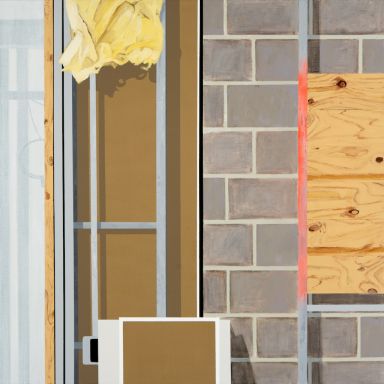
Sarah McKenzie, Interior 5 (Wall), 2009, oil on canvas, 30" x 30"
There isn't a single human figure in any of McKenzie's works of the past five years; they aren't necessary. Construction, a metaphor for human work, desire and hope stands in for actual human presence. The human urge to build is the poetry that balances the smart, crisp formal side of McKenzie's images, which are also about the artist's quest to locate and value that poetry.
In a nice coincidence, one of McKenzie's recent paintings, Big Box, is now on view at 1900 16th Street in downtown Denver, the exact type of structure that she has been depicting. The building, a 335,000 square foot 17-story glass tower, has a 24,000 square foot first floor intended for a retail tenant. Since the space is currently unoccupied, it has been given over to "Objectophilia" a themed art exhibition curated by Lauri Lynxxe Murphy, about "a love of objects so intense that individuals form emotional relationships with inanimate things."
Big Box, according to the artist, is about the perceived overlaps of art and commercial development. In her prepared statement, McKenzie puts it this way:
"Big Box depicts the interior of what will eventually become a generic, suburban office tower, one of the many types of "big boxes" which fill the Metro Denver landscape. The large, square box in the center of the composition - sheet metal ductwork, wrapped in blue plastic - is both a reference to the significance of the square in modernist painting, and a stand-in for the finished building itself."

Sarah McKenzie, Big Box, 2010, oil on canvas, 60" x 60"
It turns out that for the past decade, while Americans overbuilt the nation, Sarah McKenzie has been thinking about us. We are, it turns out, more like artists than we thought we were, putting our passions and a lot of borrowed money into buildings which are just "things." People, of course are harder to deal with than things and objects: no wonder we keep building boxes for them. Come to think of it, people are also harder to paint than buildings.
Without painting a single human figure she has told us more about American society than many of the contemporary artists who have voiced their individual complaints in the form of "identity art." As a nation we plan buildings - tangible symbols of progress - with great zeal, especially when the future and the economy feel uncertain. Wasn't the Empire State building finished during the Great Depression?
Whatever their flaws, ambitious commercial buildings are among America's greatest collective artistic creations, ready to contain our lives, the things we make, our possessions and our passions. Tom Wolfe may have been right that there was evidence of cultural self-loathing in America's love affair with glass boxes when he wrote "From Bauhaus to Our House" in 1979, but in the post 9/11 world it seems fair to point out that the act of building skyscrapers seems increasingly poignant.
Sarah McKenzie's paintings, objective as they try to be, can't help suggesting just that. As her career has progressed, she has gotten closer and closer to the heart of the matter. Heroic, creative, anxious and conscious of symbolism, Americans continue to create tangible objects to ward off chaos and assuage wounds. We are like artists.

Sarah McKenzie
John Seed and Sarah McKenzie: Q and A
JS: Do you agree with the statement that your work balances a kind of formalism with metaphorical content? What are the impulses behind your works?
SM: I agree with that statement, though some paintings fall more on the formal end of the spectrum, and others are more metaphorical.
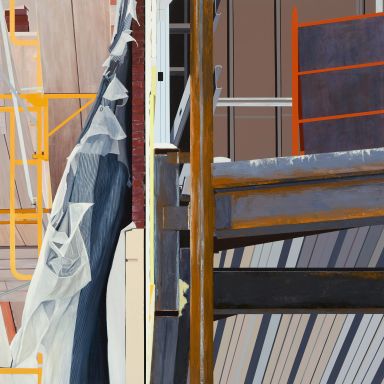
Sarah McKenzie, Seam, 2008, oil and acrylic on canvas, 72" x 72"
Seam, for example, is quite literally looking at the seam of a building, where interior and exterior meet. The canvas offers a sort of inventory of the various materials, surfaces, and textures that comprise that structure.
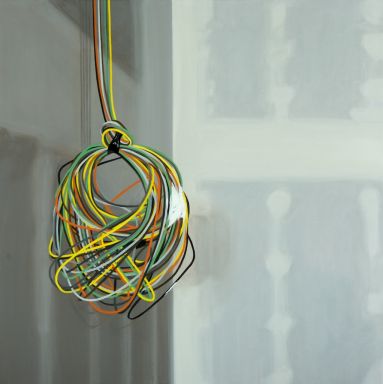
Interior 6 (Coil), 2009, oil and acrylic on canvas, 30" x 30"
Interior 6 (Coil) is a highly formal, even minimal, piece. There is a metaphor at work: I am thinking of the bundle of wiring as an abstract expressionist "gesture" against the blank white canvas/drywall. Of course, even if the viewer gets that reference, and that's a real "if," it's still a formal concept. Other paintings deal with weightier issues.
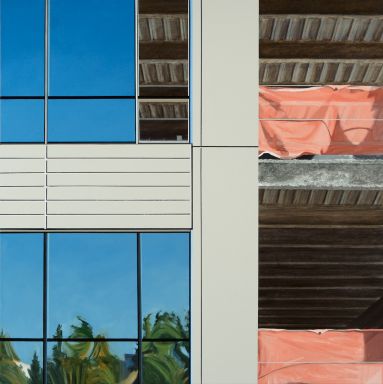
Sarah McKenzie, Exterior 1 (Plastic Trees) 2009, oil and acrylic on canvas, 30" x 30"
SM: Exterior 1 (Plastic Trees) is about the artifice of nature in the suburban landscape.
JS: In your artist's statement you mention the idea of "cracks in the American Dream." Can you point out some of the details - you call them ruptures - that allude to this?
SM: In Site, a painting from 2007, what appears at first to be a coherent image of a suburban home seen through the wooden framing of a incomplete house starts to break down as the viewer spends time exploring the composition.
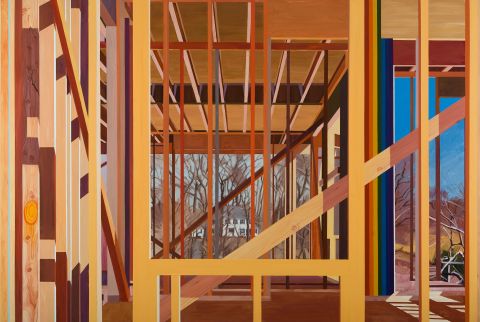
Sarah McKenzie, Site, 2007, oil on canvas, 48" x 72"
The background on the right side is handled with a different color palette than the background in the center, even though these two areas are, in reality, contiguous. Some of the strips of wood are painted in a highly detailed, photo-realistic manner, while others are simplified into bands of invented color. One of the knots in the wood has been transformed into a drippy, painted target. These inconsistencies undermine the coherence of the scene and raise questions.
JS: Who are some other contemporary artists that you admire? Some that you feel a kinship with in in terms of subject and approach?
SM: I love the work of Claire Sherman: I think she is using the organic landscape to make abstract paintings in much the same way that I am using architecture. And I feel a real affinity with the work of photographer Brad Moore, who also shows with Jen Bekman Gallery in New York. His pictures of highly manicured trees and shrubs in southern California are brilliant.
I used to teach at the Cleveland Institute of Art (from 2001-2006), and a couple of former students from the CIA - not my students per se, but artists who were in the program while I was teaching there - have gone on to make work that resonates for me. Ben Grasso and Thomas Spoerndle are two with whom I feel some kinship; Spoerndle's work is completely non-objective, and Grasso's paintings are more overtly metaphorical than mine, so they represent opposite ends of the spectrum in which I place myself.
Some other artists I admire include Daniel Dove - a former colleague in Cleveland - Eric LoPresti, Dean Monogenis, Christian Hellmich and Kevin Appel.
I've looked a lot at the artists in the Leipzig School, especially Matthias Weischer, but I'm often most influenced by other "emerging" artists.
JS: Do you see your work as ironic or objective? Both?
SM: I don't think of my work as ironic. On the contrary, I consider my paintings to be quite sincere. I find the incomplete structures that I paint to be beautiful and fascinating. It's true that I'm often disappointed by the end result when the buildings are finally completed, but I don't think that judgment is present in the work. Of course, sincerity is not the same thing as objectivity: it might even get in the way of objectivity.
I use the photographs that I take at these sites as a starting point, but I often take great liberties when creating the paintings: liberties with color, scale, visual prominence, degree of detail, and so forth. It's safe to say that I embellish a great deal. In fact, in one recent painting, Prop, I added an abstract element to the composition - a large yellow square - that is completely invented. Those kinds of inventions are things that I will continue to explore.
JS: Anything else you want people to understand about your work?
SM: The interesting thing that has come out of the economic downturn of the past two years is that it has changed the way viewers respond to my work. There's more of a tendency now for people to see my paintings as construction sites where the work has come to a halt, and the future of the project is uncertain. That interests me, and my work from 2008 on is a bit "quieter" than the earlier construction site paintings, maybe in response to this.
Links:
Sarah McKenzie is represented by:
